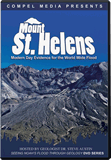Mt Ararat—Australia1
Originally published in Creation 7, no 2 (October 1984): 25.
It was a bare round-topped peak. only some 616 meters (2,002 feet) high. It was first seen by Europeans, probably around 1837.
It was a bare round-topped peak. only some 616 metres (2,002 feet) high. It was first seen by Europeans, probably around 1837, but it attracted little attention from the explorer Major Mitchell as he passed nearby.
But 1841 was a different matter. In that year Horatio Spencer Wills travelled south from the British Colony of New South Wales overland to the area of Port Phillip Bay in Victoria. From there he moved towards the Grampian Mountains of western Victoria. With his family, his flock and his herds he was looking for a new place to settle, and it was Wills who was to name the bald rounded top Mt Ararat.
Why? Wills’ diary supplies the answer. Even though his dairy was kept only as a series of spasmodic entries, he recorded his reason for naming MT Ararat. He and his family had travelled a long way to reach that spot and in the late afternoon when he dismounted wearily from his horse, over to the east was a tall shapely hill which was fading from violet to blue in the afterglow of the sunset. Wills was pleased to be able to stop to rest his animals and family in that cool and sheltered spot by an unnamed creek, and he recorded his thoughts in his diary, his friendly chatter to his dog, and his conversation with his wife. ‘Yes, tall boy (his dog, not his wife), here are fresh fields and pastures new. This is the end of our journey …’ To his wife as he pointed to the bald-topped dome, he said ‘We will call it Mt. Ararat for like the Ark, we rested there.’
Following the discovery of gold near Mt Ararat in 1854, it was not long before a tiny township sprang up about 8 km from the mountain itself. At first this settlement was also known as Mt Ararat. By 1856 ‘The Wesleyan Methodists among the diggers held preaching services in a tent, and as the population moved to and fro, the canvas chapel moved with it. For convenience in following the (gold) rushes, the tent had been mounted on wheels and this primitive church was then appropriately named ‘Noah’s Ark’.2
Around 1857, gold was discovered near the site of the current township and in 1858 the settlement was renamed Ararat. This settlement was pronounced a town in 1934 and as the population continued to grow it was declared to be a city in 1950.3
The history of the town, its naming and relationship to Noah’s Flood also shows on the town motto and coat of arms which is still used on all the Council vehicles, establishments and letterheads. In the early days of Australian history, it was the custom of Supreme Court judges whenever they were on a circuit to entertain the members of the Bar and the Press at a dinner after the close of a session. At one of these dinners Sir Redmond Barry asked about the settlement of the district. When he had been informed that the area was named by Horatio Spencer Wills, because like Noah’s Ark he had rested there after his patriarchal journey with his family in the 1840s, His Honour then inquired if it had occurred to anyone to design a coat of arms for the rapidly growing town. He suggested that it incorporate the Ark, the dove and the olive branch. The idea won immediate approval from those present and Sir Redmond was asked for the motto. Without a moment’s hesitation he gave it Gaudium adfero (I bring joy).
Footnotes
- The information used in this article was provided by Mr Alan Davies of Ararat, Victoria.
- Information supplied by Miss Banfield, granddaughter of the Mt Ararat Advertiser Editor (this newspaper has now become known as the Ararat Advertiser). Miss Banfield has researched into the local history of the area and has written two books on the topic.
- Ararat is situated some 200 km north west of Melbourne, Victoria and currently has a population of around 9,000. It acts as a service centre for a prosperous rural community. It is ironic that one of the chief industries of the Ararat area is wine production, reminiscent of one of Noah’s exploits.
Recommended Resources

Answers in Genesis is an apologetics ministry, dedicated to helping Christians defend their faith and proclaim the good news of Jesus Christ.
- Customer Service 800.778.3390
- © 2024 Answers in Genesis




